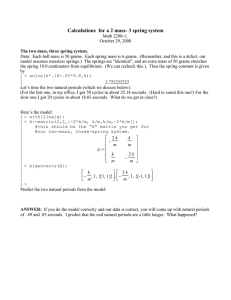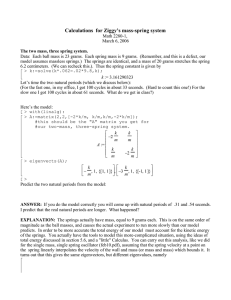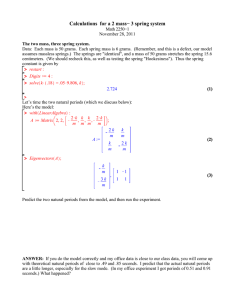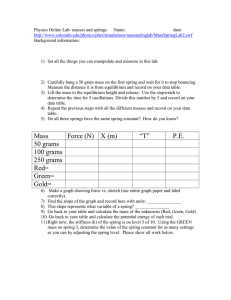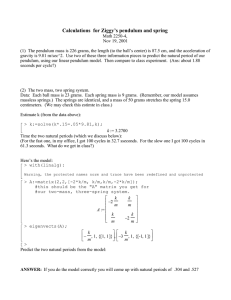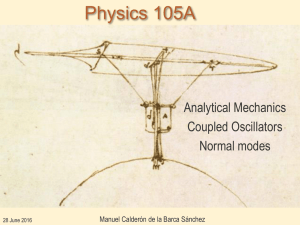Math 2250-4 Mon Apr 15 7.4 Mass-spring systems.
advertisement
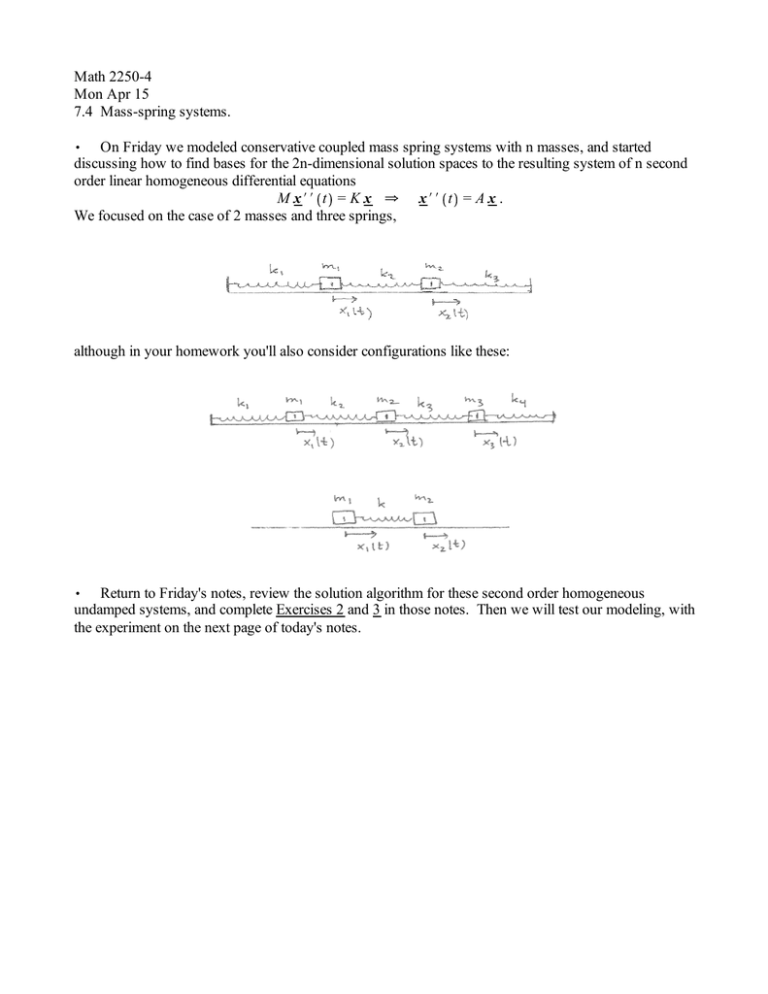
Math 2250-4 Mon Apr 15 7.4 Mass-spring systems. , On Friday we modeled conservative coupled mass spring systems with n masses, and started discussing how to find bases for the 2n-dimensional solution spaces to the resulting system of n second order linear homogeneous differential equations M x## t = K x 0 x## t = A x . We focused on the case of 2 masses and three springs, although in your homework you'll also consider configurations like these: , Return to Friday's notes, review the solution algorithm for these second order homogeneous undamped systems, and complete Exercises 2 and 3 in those notes. Then we will test our modeling, with the experiment on the next page of today's notes. The two mass, three spring system....Experiment! Data: Each mass is 50 grams. Each spring mass is 10 grams. (Remember, and this is a defect, our model assumes massless springs.) The springs are "identical", and a mass of 50 grams stretches the spring 15.6 centimeters. (We should recheck this since it's last fall's data; we should also test the spring's "Hookesiness"). With the old numbers we get Hooke's constant > Digits d 4 : > solve k$.156 = .05$9.806, k > Here's Maple confirmation for some of our work from Friday's notes: > with LinearAlgebra : A d Matrix 2, 2, K 2$k m k , m k , m 2$k ,K m ; Eigenvectors A ; K A := m k K m K k 2k m 3k m k K 2k m K1 1 , 1 1 (1) m Predict the two natural periods from the model and our experimental value of k, m. Then make the system vibrate in each mode individually and compare your prediction to the actual periods of these two fundamental modes. ANSWER: If you do the model correctly and my office data is close to our class data, you will come up with theoretical natural periods of close to .46 and .79 seconds. I predict that the actual natural periods are a little longer, especially for the slow mode. (In my office experiment I got periods of 0.482 and 0.855 seconds.) What happened? EXPLANATION: The springs actually have mass, equal to 10 grams each. This is almost on the same order of magnitude as the yellow masses, and causes the actual experiment to run more slowly than our model predicts. In order to be more accurate the total energy of our model must account for the kinetic energy of the springs. You actually have the tools to model this more-complicated situation, using the ideas of total energy discussed in section 5.6, and a "little" Calculus. You can carry out this analysis, like I sketched (but did not discuss in class) for the single mass, single spring oscillator http://www.math.utah. edu/~korevaar/2250spring13/mar6.pdf, assuming that the spring velocity at a point on the spring linearly interpolates the velocity of the wall and mass (or mass and mass) which bounds it. It turns out that this gives an A-matrix the same eigenvectors, but different eigenvalues, namely 6k l1 = K 6 m C 5 ms 6k l2 = K . 2 m C ms (The "M" matrix is not diagonal but the "K" matrix is the same.) If you use these values, then you get period predictions > m d .05; ms d .010; k d 3.143; 6$k 6$m C 5$ms ; 6$k Omega2 d 2$m C ms ; 2$Pi T1 d evalf Omega1 ; 2$Pi T2 d evalf Omega2 ; Omega1 d m := 0.05 ms := 0.010 k := 3.143 W1 := 7.340 W2 := 13.09 T1 := 0.8559 T2 := 0.4801 of .856 and .480 seconds per cycle. Is that closer? (2) Exercise 2) Consider a train with two cars connected by a spring: 2a) Derive the linear system of DEs that governs the dynamics of this configuration (it's actually a special case of what we did before, with two of the spring constants equal to zero) 2b). Find the eigenvalues and eigenvectors. Then find the general solution. For l = 0 and its corresponding eigenvector v verify that you get two solutions x t = v and x t = t v , rather than the expected cos w t v, sin w t v . Interpret these solutions in terms of train motions. You will use these ideas in some of your homework problems.
